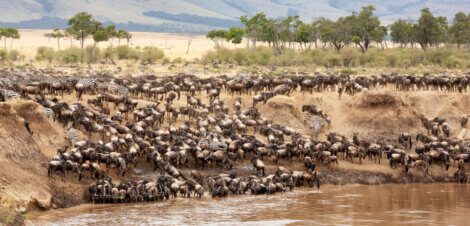All About Migratory Animals

Every year, many migratory animals undertake a long journey to find new resources. They don’t all do it at the same time, but each species does have its own cycle which repeats each year.
Changes in space, weather, and the availability of resources are the main reason why animals migrate. The journey is often long and with many obstacles, and some animals may not survive. Read on to find out more about this incredible natural phenomenon.
What is migration?
Migration is a natural event whereby animals are instinctively driven to move to another habitat each year. This normally happens at the same time each year, and the new habitat could be many miles away.
This being said, not all animal movements are classed as migration. In order to be categorized as animal migration, the following criteria need to be met:
- The journey needs to be a certain length and duration. Some last for months.
- There needs to be a marked difference between their new and old habitats.
- It’s regulated by the animals’ internal biological clock which adapts to external stimuli.
- It needs to involve a significant number of animals. A lone individual isn’t enough. Migration involves either a large group or the entire population.
- Migration should be a response to different ecological pressures.
- They either move to the new area during a period when there’s an abundance of food, or they use a new area for specific functions, such as breeding or raising young.
The aim of migrating is to find better resources or avoid adverse environmental conditions. The lack of resources in one habitat will force the animal to look for other places to find food. This could be influenced by environmental changes.
In general, migratory animals migrate in warm areas in autumn and return to their original habitat in the spring. Amazingly, their ability to navigate between their habitats seems to be in their genes.
Migratory animals that migrate every year
There are many different animals that migrate every year and they’re all fascinating. They face great danger along the way, but the risk is equally weighted against the resources that they’ll find in their new habitat. Let’s take a look at some examples.
The brave gnus of the Serengeti
The majority of the Gnus in the world live in the Serengeti National Park. From November to April, they feed in the south, where there are rich pastures. This is also where they raise their young until the supply of food begins to dry up.
Once the babies are three or four weeks old, the group beings to move and cross the dry and dangerous lands to the north. The journey is long and there are many threats. Just on the border between Tanzania and Kenya is the River Mara, where predators like Crocodiles await them.
The mortality of their young is very high, and only one in every six will survive. Up to 6,000 gnus can die every year during this migration journey. They finally reach their destination between July and October.
Adult gnus have a good visual memory and know exactly where they need to go. Two or three adult males guide the group on their journey towards more humid areas. These ‘leaders’ use the sun, visual references, their sense of smell, and the knowledge of the herd to guide them.

The whale’s long migration journey
Whales migrate in search of a place to raise their young. When summer arrives, they can travel thousands of miles to areas where there’s an explosion of phytoplankton because of the abundance of sunlight. This increases the number of krill, the main source of food for whales and other predators.
To guide themselves, whales use the earth’s magnetic field. They also use the coastline as a visual reference, although they keep well out to sea. It’s believed that the dolphins and whales that get stranded on the beach each year do so because of changes in the earth’s magnetic field.
This causes them to swim towards the coast instead of staying out to sea. The magnetic field can change, and for a while, these animals will be slightly disorientated.

Migratory birds
There are many species of migratory birds and each one makes an annual journey that’s so accurate that it’s as if they have a map of the sky. The main flight paths are:
- Palearctic-African route: this is one of the most surprising. It can be seen from the strait of Gibraltar since migratory birds rest on the Iberian Peninsula on their way to Africa.
- From north-east to south-east Asia.
- From North to South America.

As you can see, animal migration is a veritable odyssey. Migratory animals can use up huge amounts of energy to travel this journey every year, and often, the journey is fraught with danger. It’s an instinctive behavior, although part of it is learned, and it’s passed on from generation to generation.
All cited sources were thoroughly reviewed by our team to ensure their quality, reliability, currency, and validity. The bibliography of this article was considered reliable and of academic or scientific accuracy.
- National Geographic. Grandes Migraciones.
- Drickamer, L.C, Vessey, S.H. y Jacobs, E.M. “Animal Behavior: Mechanism, Ecology, Evolution”, Ed.Mc Graw Hill (2002).
- Breed, M.D and Moore,J. “Animal Behavior” Editorial Academic Press, Elsevier (2011).
This text is provided for informational purposes only and does not replace consultation with a professional. If in doubt, consult your specialist.